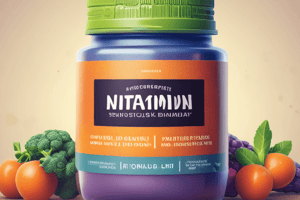Podcast
Questions and Answers
What is the approximate percentage of copper absorption when intake is 90%?
What is the approximate percentage of copper absorption when intake is 90%?
50%
What substances in foods like cassava and millet inhibit the transfer of iodine to the thyroid gland?
What substances in foods like cassava and millet inhibit the transfer of iodine to the thyroid gland?
Goitrogens
What is the most damaging effect of iodine deficiency?
What is the most damaging effect of iodine deficiency?
Damage to the developing brain
What is the role of selenium in the body?
What is the role of selenium in the body?
What foods are reliable sources of selenium?
What foods are reliable sources of selenium?
What is the bioavailability of selenium from food sources?
What is the bioavailability of selenium from food sources?
What is the effect of selenium deficiency on the body?
What is the effect of selenium deficiency on the body?
What is the role of thyroid hormone in the body?
What is the role of thyroid hormone in the body?
What is the visible sign of iodine deficiency?
What is the visible sign of iodine deficiency?
What is the effect of excess selenium intake on the body?
What is the effect of excess selenium intake on the body?
Flashcards are hidden until you start studying
Study Notes
Vitamins
- Fat-soluble vitamins can be stored in the liver and other fat storage sites and are made available when one is on a vitamin-deficient diet.
- Vitamin A (retinol) is structurally related to carotenoid pigments and is found in plants and animal sources.
- Vitamin A is essential for building cells, enables growth of all cells, helps normal tooth formation, and is essential for the normal reproductive function in males.
- It plays a major role in maintaining normal vision, maintaining the myelin sheath of nervous tissue, and provides resistance to infection.
- Vitamin A and carotenoids fight against cancer of the skin and reduce the risk of heart diseases.
Vitamin C
- Vitamin C is essential for the formation of collagen, takes part in oxidation and reduction reactions in tissues, and is necessary for the formation of red blood cells.
- It takes place in cholesterol metabolism, is necessary for rapid healing of wounds, and helps in the absorption of calcium.
- Citrus fruits, Indian gooseberry, and tomatoes are excellent sources of vitamin C.
Minerals
- Minerals are inorganic species that play key functional roles in health and nutrition.
- There are 25 essential minerals that are present in living cells, divided into two groups: major minerals (found in bulk concentrations in the body) and microminerals (found in very small concentrations).
Phosphorus
- Phosphorus is part of DNA and RNA, assists in energy metabolism, and is essential for the formation of bones and teeth.
- It is found naturally in many foods, especially animal-source foods, and is absorbed well from most foods.
- Risks related to inadequate intake of phosphorus include poor appetite, anxiety, and irritability, while excessive intake may interfere with calcium metabolism.
Potassium
- Potassium is the body's principal positively charged ion inside cells, essential for maintenance of normal fluid and electrolyte balance, enzyme reactions, cell integrity, and muscle contraction.
- It is found in natural, unprocessed foods, especially fruits and vegetables, and is linked to an organic anion.
- Risks related to inadequate or excess intake of potassium include increased risk of kidney stones, bone demineralization, and stroke.
Microminerals
- Microminerals occur in living tissues in minute amounts and are required in amounts less than 100 mg/day.
- The micro-minerals are subdivided into three groups: essential trace elements, non-essential trace elements, and potentially toxic trace elements.
Copper
- Copper is an essential trace element, vital for enzymatic processes of the living cell.
- Copper absorption depends on copper intake, and absorption rates are approximately 50% when intakes are below 90%.
Iodine
- Iodine is an essential trace element, vital for the production of thyroid hormones.
- Iodine deficiency has adverse effects at all stages of development, particularly damaging to the developing brain.
- Risks related to inadequate intake of iodine include thyroid enlargement, or goitre, and higher risk for mental retardation.
Selenium
- Selenium is an antioxidant nutrient, protecting the body against oxidative stress.
- Selenium regulates thyroid hormone and oxidative reduction reactions of vitamin C.
- Selenium is found in seafood, meat, whole grains, dairy, fruits, and vegetables, and its bioavailability from food sources is highly bioavailable.
- Risks related to inadequate intake of selenium are very rare.
Studying That Suits You
Use AI to generate personalized quizzes and flashcards to suit your learning preferences.




